Home >> Diversity and classification >> True fungi >> Dikarya >> Basidiomycota >> Ustilaginomycotina
USTILAGINOMYCOTINA: THE SMUTS AND THEIR ALLIES
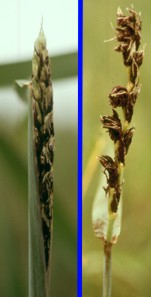
Smut fungi have earned their sordid name from the masses of black powdery teliospores that many of them produce. All are parasites of flowering plants and are common throughout the world. Although they are obligate plant parasites in the dikaryotic parts of their life cycles most can grow as saprotrophs in the monokaryotic state.
Ustilago tritici, a common parasite of cultivated wheat, barley and rye, seen on wheat in the picture at left, is a fairly typical smut. It colonizes the germinating wheat seeds early in the season and grows in the plant tissues as they develop. It finally comes to occupy the tissues of the developing spikes (flowering parts). At the time the flowers should be appearing in the spikes the mycelium fragments to produces the powdery mass of teliospores seen in young and mature spikes in the picture. The infected spikes mature before the uninfected ones do and the teliospores are therefore carried by wind to immature healthy spikes. In this way the fungus is able to colonize many plants before flowering ends. Although a typical smut in many ways U. tritici is unusual in not producing basidia. Instead the teliospores overwinter with the seeds and germinate to produce hyphae at the time the seeds are germinating. Fertilization and re-establishment of the dikaryon is accomplished by hyphal fusion. The related species U. hordei, also on barley and rye, differs in producing basidia and basidiospores from the germinating teliospores.

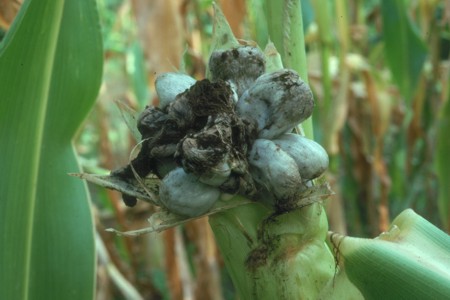
Ustilago maydis, the corn smut, is a very common fungus found wherever corn or maize is grown. Its life cycle is typical of many grass smuts, but because corn has such large flowering spikes its effect can be spectacular. In the photo at right an ear of corn has been partially invaded by U. maydis and some of its kernals caused to grow to an immense size. The fungus has grown in these swollen tissues and then converted its hyphae into millions of dusty teliospores. When the kernals are swollen, but before teliospores are produced, they can be cooked and eaten. In central Mexico where corn has been cultivated since prehistic times, the young smut galls, called huitlacoche, are used in a variety of dishes that today can be found even in classy restaurants.
The teliospores of corn smut spend the winter on the ground and germinate in the spring to produce basidia (called "promycelia" by many mycologists) and basidiospores. The picture at far right shows one such teliospore germinating to produce a basidium with two basidiospores. This is not exactly a textbook illustration, the basidium has only three cells, and has two, not four basidiospores. If fact, there is probably a thin septum separating the parts of the basidium bearing the two spores and thus there really are four cells there. None of this is unusual in U. maydis, where teliospore germination can be somewhat irregular. The basidiospores themselves will germinate to produce more cells which grow as yeasts until the dikaryon is established.
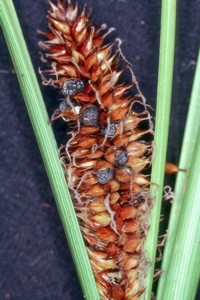
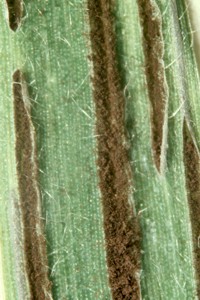

Not all smuts occur on grasses, although they are the most commonly encountered hosts. Species of Cintractia are parasites of the family Cyperaceae, particularly the large genus Carex. In the picture at left the flowering spike of a species of Carex has become colonized by Cintractia fischeri which has replaced several of the florets with masses of teliospores.
In addition, not all smuts produce their teliospores in the flowers of their host. The smut at right, Ustilago spegazzinii is producing its teliospores on the culm (stem) of twitch grass (Elytrigia repens) a fairly common occurrence in grass smuts. Urocystis agropyri, at far right, produces teliospores in the leaves of its host, also twitch grass
Some Ustilaginomycota do not really fit the image of a smut at all. Although nearly all are plant parasites some are distinctly un-smutty. For example species of Doassansia, long included with the smuts, occur exclusively on aquatic dicotyledons and have colourless teliospores produced in balls that are never powdery. The least smut-like of all are the Exobasidiales.
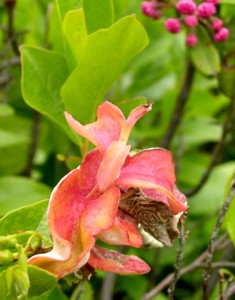
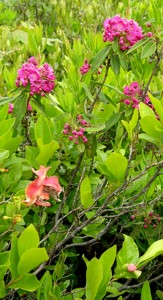 The picture at near right at first appears to depict only flowers of sheep laurel (Kalmia angustifolia) as they are so commonly seen in our northern bogs and forests. But the "flower" lowest in the picture looks strange, rather faded and unlike the others. Close examination, as in the rightmost picture, reveals that the strange "flower" is made up of enlarged and distorted leaves of another plant, sourtop blueberry (Vaccinium myrtilloides), and not sheelp laurel at all. This colourful deformity is cause by Exobasidium myrtilli, a relative of the smuts. The red leaves become covered with basidia and basidiospores as maturity proceeds. The Exobasidiales are all parasites of the blueberry family (Ericaceae). Nearly all of them cause brightly coloured galls and swellings on their host plant that resemble those produced by members of the unrelated genus Taphrina, a member of the Ascomycota.
The picture at near right at first appears to depict only flowers of sheep laurel (Kalmia angustifolia) as they are so commonly seen in our northern bogs and forests. But the "flower" lowest in the picture looks strange, rather faded and unlike the others. Close examination, as in the rightmost picture, reveals that the strange "flower" is made up of enlarged and distorted leaves of another plant, sourtop blueberry (Vaccinium myrtilloides), and not sheelp laurel at all. This colourful deformity is cause by Exobasidium myrtilli, a relative of the smuts. The red leaves become covered with basidia and basidiospores as maturity proceeds. The Exobasidiales are all parasites of the blueberry family (Ericaceae). Nearly all of them cause brightly coloured galls and swellings on their host plant that resemble those produced by members of the unrelated genus Taphrina, a member of the Ascomycota.